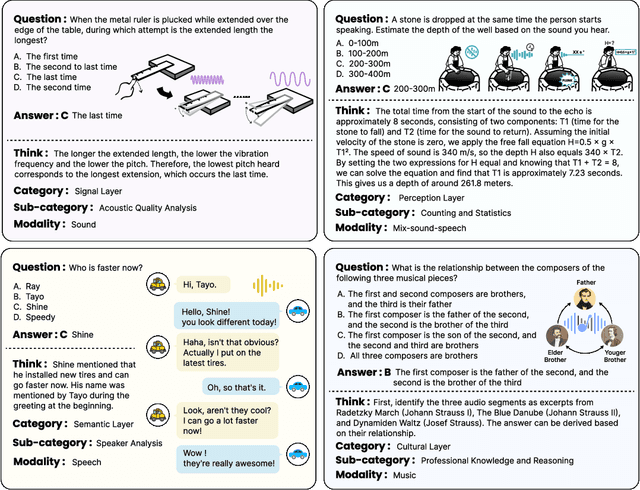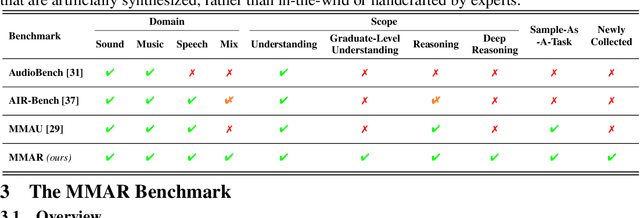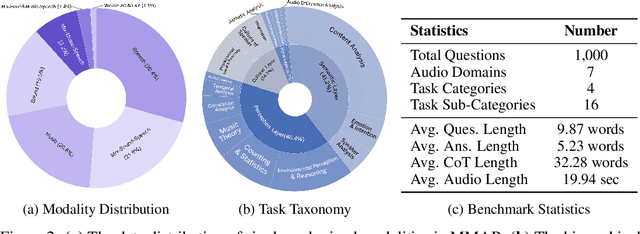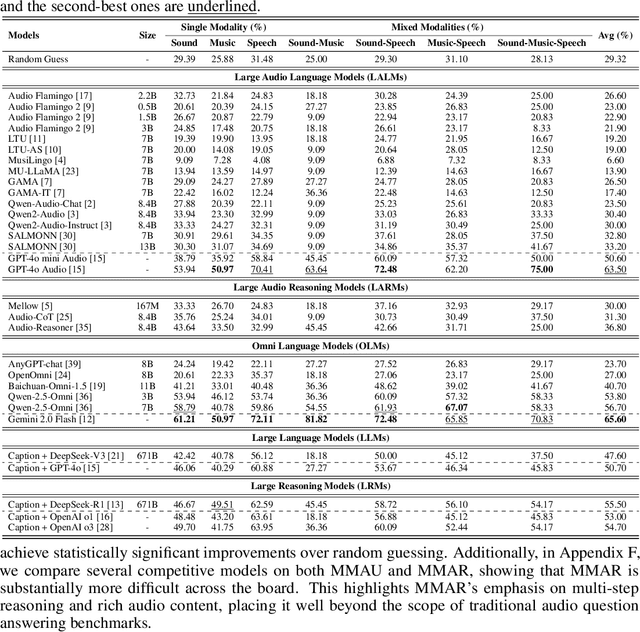Yuanzhe Chen
Towards Reliable Large Audio Language Model
May 25, 2025Abstract:Recent advancements in large audio language models (LALMs) have demonstrated impressive results and promising prospects in universal understanding and reasoning across speech, music, and general sound. However, these models still lack the ability to recognize their knowledge boundaries and refuse to answer questions they don't know proactively. While there have been successful attempts to enhance the reliability of LLMs, reliable LALMs remain largely unexplored. In this paper, we systematically investigate various approaches towards reliable LALMs, including training-free methods such as multi-modal chain-of-thought (MCoT), and training-based methods such as supervised fine-tuning (SFT). Besides, we identify the limitations of previous evaluation metrics and propose a new metric, the Reliability Gain Index (RGI), to assess the effectiveness of different reliable methods. Our findings suggest that both training-free and training-based methods enhance the reliability of LALMs to different extents. Moreover, we find that awareness of reliability is a "meta ability", which can be transferred across different audio modalities, although significant structural and content differences exist among sound, music, and speech.
AudioMorphix: Training-free audio editing with diffusion probabilistic models
May 21, 2025



Abstract:Editing sound with precision is a crucial yet underexplored challenge in audio content creation. While existing works can manipulate sounds by text instructions or audio exemplar pairs, they often struggled to modify audio content precisely while preserving fidelity to the original recording. In this work, we introduce a novel editing approach that enables localized modifications to specific time-frequency regions while keeping the remaining of the audio intact by operating on spectrograms directly. To achieve this, we propose AudioMorphix, a training-free audio editor that manipulates a target region on the spectrogram by referring to another recording. Inspired by morphing theory, we conceptualize audio mixing as a process where different sounds blend seamlessly through morphing and can be decomposed back into individual components via demorphing. Our AudioMorphix optimizes the noised latent conditioned on raw input and reference audio while rectifying the guided diffusion process through a series of energy functions. Additionally, we enhance self-attention layers with a cache mechanism to preserve detailed characteristics from the original recordings. To advance audio editing research, we devise a new evaluation benchmark, which includes a curated dataset with a variety of editing instructions. Extensive experiments demonstrate that AudioMorphix yields promising performance on various audio editing tasks, including addition, removal, time shifting and stretching, and pitch shifting, achieving high fidelity and precision. Demo and code are available at this url.
MMAR: A Challenging Benchmark for Deep Reasoning in Speech, Audio, Music, and Their Mix
May 19, 2025



Abstract:We introduce MMAR, a new benchmark designed to evaluate the deep reasoning capabilities of Audio-Language Models (ALMs) across massive multi-disciplinary tasks. MMAR comprises 1,000 meticulously curated audio-question-answer triplets, collected from real-world internet videos and refined through iterative error corrections and quality checks to ensure high quality. Unlike existing benchmarks that are limited to specific domains of sound, music, or speech, MMAR extends them to a broad spectrum of real-world audio scenarios, including mixed-modality combinations of sound, music, and speech. Each question in MMAR is hierarchically categorized across four reasoning layers: Signal, Perception, Semantic, and Cultural, with additional sub-categories within each layer to reflect task diversity and complexity. To further foster research in this area, we annotate every question with a Chain-of-Thought (CoT) rationale to promote future advancements in audio reasoning. Each item in the benchmark demands multi-step deep reasoning beyond surface-level understanding. Moreover, a part of the questions requires graduate-level perceptual and domain-specific knowledge, elevating the benchmark's difficulty and depth. We evaluate MMAR using a broad set of models, including Large Audio-Language Models (LALMs), Large Audio Reasoning Models (LARMs), Omni Language Models (OLMs), Large Language Models (LLMs), and Large Reasoning Models (LRMs), with audio caption inputs. The performance of these models on MMAR highlights the benchmark's challenging nature, and our analysis further reveals critical limitations of understanding and reasoning capabilities among current models. We hope MMAR will serve as a catalyst for future advances in this important but little-explored area.
StreamVoice+: Evolving into End-to-end Streaming Zero-shot Voice Conversion
Aug 05, 2024


Abstract:StreamVoice has recently pushed the boundaries of zero-shot voice conversion (VC) in the streaming domain. It uses a streamable language model (LM) with a context-aware approach to convert semantic features from automatic speech recognition (ASR) into acoustic features with the desired speaker timbre. Despite its innovations, StreamVoice faces challenges due to its dependency on a streaming ASR within a cascaded framework, which complicates system deployment and optimization, affects VC system's design and performance based on the choice of ASR, and struggles with conversion stability when faced with low-quality semantic inputs. To overcome these limitations, we introduce StreamVoice+, an enhanced LM-based end-to-end streaming framework that operates independently of streaming ASR. StreamVoice+ integrates a semantic encoder and a connector with the original StreamVoice framework, now trained using a non-streaming ASR. This model undergoes a two-stage training process: initially, the StreamVoice backbone is pre-trained for voice conversion and the semantic encoder for robust semantic extraction. Subsequently, the system is fine-tuned end-to-end, incorporating a LoRA matrix to activate comprehensive streaming functionality. Furthermore, StreamVoice+ mainly introduces two strategic enhancements to boost conversion quality: a residual compensation mechanism in the connector to ensure effective semantic transmission and a self-refinement strategy that leverages pseudo-parallel speech pairs generated by the conversion backbone to improve speech decoupling. Experiments demonstrate that StreamVoice+ not only achieves higher naturalness and speaker similarity in voice conversion than its predecessor but also provides versatile support for both streaming and non-streaming conversion scenarios.
Improving Audio Generation with Visual Enhanced Caption
Jul 05, 2024Abstract:Generative models have shown significant achievements in audio generation tasks. However, existing models struggle with complex and detailed prompts, leading to potential performance degradation. We hypothesize that this problem stems from the low quality and relatively small quantity of training data. In this work, we aim to create a large-scale audio dataset with rich captions for improving audio generation models. We develop an automated pipeline to generate detailed captions for audio-visual datasets by transforming predicted visual captions, audio captions, and tagging labels into comprehensive descriptions using a Large Language Model (LLM). We introduce Sound-VECaps, a dataset comprising 1.66M high-quality audio-caption pairs with enriched details including audio event orders, occurred places and environment information. We demonstrate that training with Sound-VECaps significantly enhances the capability of text-to-audio generation models to comprehend and generate audio from complex input prompts, improving overall system performance. Furthermore, we conduct ablation studies of Sound-VECaps across several audio-language tasks, suggesting its potential in advancing audio-text representation learning. Our dataset and models are available online.
Seed-TTS: A Family of High-Quality Versatile Speech Generation Models
Jun 04, 2024



Abstract:We introduce Seed-TTS, a family of large-scale autoregressive text-to-speech (TTS) models capable of generating speech that is virtually indistinguishable from human speech. Seed-TTS serves as a foundation model for speech generation and excels in speech in-context learning, achieving performance in speaker similarity and naturalness that matches ground truth human speech in both objective and subjective evaluations. With fine-tuning, we achieve even higher subjective scores across these metrics. Seed-TTS offers superior controllability over various speech attributes such as emotion and is capable of generating highly expressive and diverse speech for speakers in the wild. Furthermore, we propose a self-distillation method for speech factorization, as well as a reinforcement learning approach to enhance model robustness, speaker similarity, and controllability. We additionally present a non-autoregressive (NAR) variant of the Seed-TTS model, named $\text{Seed-TTS}_\text{DiT}$, which utilizes a fully diffusion-based architecture. Unlike previous NAR-based TTS systems, $\text{Seed-TTS}_\text{DiT}$ does not depend on pre-estimated phoneme durations and performs speech generation through end-to-end processing. We demonstrate that this variant achieves comparable performance to the language model-based variant and showcase its effectiveness in speech editing. We encourage readers to listen to demos at \url{https://bytedancespeech.github.io/seedtts_tech_report}.
T-CLAP: Temporal-Enhanced Contrastive Language-Audio Pretraining
Apr 27, 2024



Abstract:Contrastive language-audio pretraining~(CLAP) has been developed to align the representations of audio and language, achieving remarkable performance in retrieval and classification tasks. However, current CLAP struggles to capture temporal information within audio and text features, presenting substantial limitations for tasks such as audio retrieval and generation. To address this gap, we introduce T-CLAP, a temporal-enhanced CLAP model. We use Large Language Models~(LLMs) and mixed-up strategies to generate temporal-contrastive captions for audio clips from extensive audio-text datasets. Subsequently, a new temporal-focused contrastive loss is designed to fine-tune the CLAP model by incorporating these synthetic data. We conduct comprehensive experiments and analysis in multiple downstream tasks. T-CLAP shows improved capability in capturing the temporal relationship of sound events and outperforms state-of-the-art models by a significant margin.
StreamVoice: Streamable Context-Aware Language Modeling for Real-time Zero-Shot Voice Conversion
Feb 07, 2024Abstract:Recent language model (LM) advancements have showcased impressive zero-shot voice conversion (VC) performance. However, existing LM-based VC models usually apply offline conversion from source semantics to acoustic features, demanding the complete source speech, and limiting their deployment to real-time applications. In this paper, we introduce StreamVoice, a novel streaming LM-based model for zero-shot VC, facilitating real-time conversion given arbitrary speaker prompts and source speech. Specifically, to enable streaming capability, StreamVoice employs a fully causal context-aware LM with a temporal-independent acoustic predictor, while alternately processing semantic and acoustic features at each time step of autoregression which eliminates the dependence on complete source speech. To address the potential performance degradation from the incomplete context in streaming processing, we enhance the context-awareness of the LM through two strategies: 1) teacher-guided context foresight, using a teacher model to summarize the present and future semantic context during training to guide the model's forecasting for missing context; 2) semantic masking strategy, promoting acoustic prediction from preceding corrupted semantic and acoustic input, enhancing context-learning ability. Notably, StreamVoice is the first LM-based streaming zero-shot VC model without any future look-ahead. Experimental results demonstrate StreamVoice's streaming conversion capability while maintaining zero-shot performance comparable to non-streaming VC systems.
LM-VC: Zero-shot Voice Conversion via Speech Generation based on Language Models
Jun 18, 2023Abstract:Language model (LM) based audio generation frameworks, e.g., AudioLM, have recently achieved new state-of-the-art performance in zero-shot audio generation. In this paper, we explore the feasibility of LMs for zero-shot voice conversion. An intuitive approach is to follow AudioLM - Tokenizing speech into semantic and acoustic tokens respectively by HuBERT and SoundStream, and converting source semantic tokens to target acoustic tokens conditioned on acoustic tokens of the target speaker. However, such an approach encounters several issues: 1) the linguistic content contained in semantic tokens may get dispersed during multi-layer modeling while the lengthy speech input in the voice conversion task makes contextual learning even harder; 2) the semantic tokens still contain speaker-related information, which may be leaked to the target speech, lowering the target speaker similarity; 3) the generation diversity in the sampling of the LM can lead to unexpected outcomes during inference, leading to unnatural pronunciation and speech quality degradation. To mitigate these problems, we propose LM-VC, a two-stage language modeling approach that generates coarse acoustic tokens for recovering the source linguistic content and target speaker's timbre, and then reconstructs the fine for acoustic details as converted speech. Specifically, to enhance content preservation and facilitates better disentanglement, a masked prefix LM with a mask prediction strategy is used for coarse acoustic modeling. This model is encouraged to recover the masked content from the surrounding context and generate target speech based on the target speaker's utterance and corrupted semantic tokens. Besides, to further alleviate the sampling error in the generation, an external LM, which employs window attention to capture the local acoustic relations, is introduced to participate in the coarse acoustic modeling.
Multi-level Temporal-channel Speaker Retrieval for Robust Zero-shot Voice Conversion
May 12, 2023Abstract:Zero-shot voice conversion (VC) converts source speech into the voice of any desired speaker using only one utterance of the speaker without requiring additional model updates. Typical methods use a speaker representation from a pre-trained speaker verification (SV) model or learn speaker representation during VC training to achieve zero-shot VC. However, existing speaker modeling methods overlook the variation of speaker information richness in temporal and frequency channel dimensions of speech. This insufficient speaker modeling hampers the ability of the VC model to accurately represent unseen speakers who are not in the training dataset. In this study, we present a robust zero-shot VC model with multi-level temporal-channel retrieval, referred to as MTCR-VC. Specifically, to flexibly adapt to the dynamic-variant speaker characteristic in the temporal and channel axis of the speech, we propose a novel fine-grained speaker modeling method, called temporal-channel retrieval (TCR), to find out when and where speaker information appears in speech. It retrieves variable-length speaker representation from both temporal and channel dimensions under the guidance of a pre-trained SV model. Besides, inspired by the hierarchical process of human speech production, the MTCR speaker module stacks several TCR blocks to extract speaker representations from multi-granularity levels. Furthermore, to achieve better speech disentanglement and reconstruction, we introduce a cycle-based training strategy to simulate zero-shot inference recurrently. We adopt perpetual constraints on three aspects, including content, style, and speaker, to drive this process. Experiments demonstrate that MTCR-VC is superior to the previous zero-shot VC methods in modeling speaker timbre while maintaining good speech naturalness.
 Add to Chrome
Add to Chrome Add to Firefox
Add to Firefox Add to Edge
Add to Edge